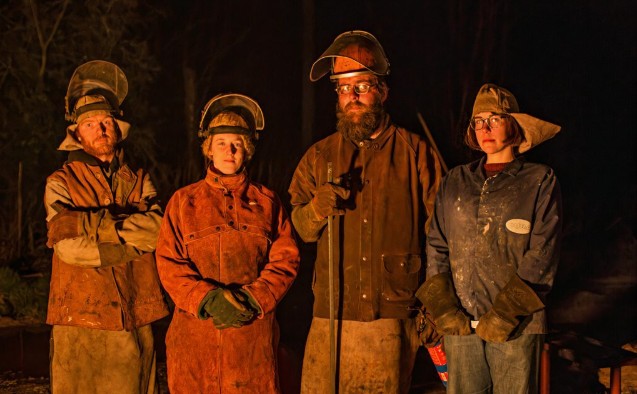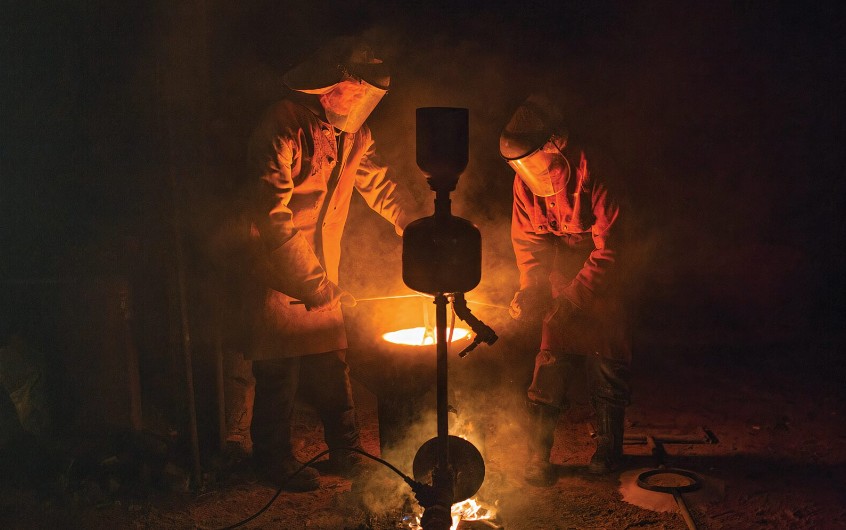Published in Perspective
August 2023
Heat haze ripples in a Dorset field. There is a steady roar. Four of us in helmets, goggles, leather aprons and heatproof gloves are staggering under the liquid weight of 80 kilos of molten iron. Directions are called out from ahead: “Forward! Left a bit! Almost there!” We reach the waiting mould. “Pour!” As we tip the container a stream of orange metal flows out, somehow sluggish and rapid at the same time, spitting back fiery globs that sizzle on the grass. “Next!” We manoeuvre towards the next mould. It is like being part of a military operation.
Except there’s a lot more cider here, and all the participants’ helmets are pink. This is the annual Dorset Iron Pour at the edge of Cranborne Chase, organised by Steve Coles and his wife Necole Schmitz. If you asked someone to draw a picture of a blacksmith, they would probably draw Steve: built like an ox, with a bushy brown beard, strong forearms and a shining face streaked with soot and grime. His foundry, Coles Castings, is housed in a barn on his family’s farm.
The furnace, a steel “cupola” model shaped like an upright cylinder, has been transported here all the way from Wales. A fearsome thing, it is called the Rhino and it runs at 1,400 degrees Celsius; over the course of this weekend it will burn through a third of a tonne of coke. Into its maw is tossed broken-up bathtubs, drainpipes, brake discs, manhole covers and other fragments of scrap iron, which melt in just ten minutes. Despite its team’s professionalism, merely looking at the Rhino puts the fear of God into me. Or perhaps the fear of Perkūnas. More on him later.
Sixty people are gathered here in leathers and other foundry wear, sweatily alternating roles on this blazing afternoon. They come from England, Wales and the US (Necole is American), but there is also a contingent from Latvia and Lithuania. The Dorset Iron Pour is a glimpse into an artisanal metal-casting community that connects this West Country field with Eastern Europe and the Baltic. Its DIY ethos merges this deeply traditional craft with a spirit that – with all the leathers and metal – feels distinctly punk.
According to Steve, today’s resurgence dates back to the 1950s, when American sculptor Julius Schmidt started experimenting with small-scale casting in order to make artworks. Essentially, he and other pioneers reverse-engineered the process from modern industrial blast furnaces back to something that more resembled the cottage industries of the eighteenth and nineteenth centuries. “The scene was a bit like the Wild West, with everyone working things out for themselves.” Much of the craft had to be relearned through trial and error.
My initiation into this community comes through another man at the pour, the artist and bell-founder David Snoo Wilson. Also bearded – ginger, not brown – and wearing a battered leather hood that gives him the look of a steampunk monk, David’s path has been one of trial and error too. Working in bronze, he made his first bell in the garden of a derelict East London pub to ring out last orders at the culmination of a three-day eviction party. How did it go? “Terrible,” he says, “the mould cracked. The bell did work, but it looked like a mouse had nibbled its side.” The next attempt, at Spain’s Nowhere Festival, went similarly pear-shaped. These setbacks fuelled his impulse to learn; in 2014 he embarked on a road trip to study bell-making techniques in traditional foundries in Central and Eastern Europe. But the bell-founders there were secretive. “I had to pretend that I was researching lore, not the process itself.”

David Snoo Wilson, Jo Lathwood, Steve Coles, Anna Barrett
Along with fellow artist Jo Lathwood – currently clad in heatproof leathers, directing another team to the moulds – he went on to establish Ore + Ingot, a “travelling foundry” casting bells as live performance events. In their masks and cumbersome gear they found it difficult to be heard, so in 2015 they invited me to join them as a storyteller. They gave me a crash course in melting bronze and stuck a helmet on my head. With a furnace made from old gas canisters, unloaded out of the back of a van, we cast bells for several years across the UK.
Just as artisanal iron-casters went back to first principles, David and Jo reinvented a tradition of itinerant bell-founders. Before industrialisation, when transporting heavy objects by road was much more difficult, bells were often made on site at the churches they would hang in. During my time with Ore + Ingot, I learned that the craft of bell-founding – which stretches back 5,000 years all the way to ancient China – is steeped in tradition and superstition, some of which endures today. In Germany, bells were embossed with sage leaves as symbols of good luck, and across Europe they were plunged into water before being rung for the first time – a symbolic baptism to endow them with a soul. In England, itinerant founders would ask the local lord for silver to give the bell “a nice silvery ring”. The silver probably ended up in the founder’s back pocket, but no one was the wiser.
Metallurgy – whether in iron or bronze – has deep mythological roots. Long before the extraction of ores, the first iron to be worked by humans fell to earth as meteorites, which may explain the common cultural link between the gods, iron and the sky. Thor, Norse god of thunderstorms, wielded an iron hammer. Perkūnas – I mentioned him earlier – was the Baltic god not only of thunder and lightning but of iron and oak (oaks were believed to be the tree most often lightning-struck). Other ferric deities include the Greek blacksmith-god Hephaestus, whose forge was an active volcano, the divine artificer Vishvakarma in the Hindu pantheon, and Ogun, god of iron and metalworking in West African Yoruba and Haitian Vodou. In England, the Anglo-Saxons brought legends of Wayland the Smith, a master blacksmith who wrecked revenge on a king who enslaved him for his craft. The Neolithic barrow of Wayland’s Smithy, to which that myth became attached, can be found in Wiltshire, not 50 miles from Steve’s farm.
The power of transforming metal – that alchemical transmutation between its solid and liquid states – does seem a lot like magic. No wonder the craft was sacred. In keeping with connotations of physical strength and weaponry, it is notable that the gods of iron were also largely male. The image of big bearded men shouting over the furnace roar, with the clash of metal, fire and smoke, is certainly one part of this pour – but, with a roughly equal ratio here of women to men, this is another example of traditions being reinvented. Unsurprisingly, says Steve, macho behaviour invariably causes accidents. This perhaps explains why the helmets here are pink. When he and Necole shopped for foundry wear, they discovered, amusingly, that pink helmets cost half the price, and the colour seemed to help in tempering machismo.
Things at the Dorset Iron Pour are changing at a material level too. With the closure of coal mines and refineries, the coke on which the Rhino runs is proving harder to source; and there is the additional problem of its high carbon emissions. So Coles Castings is moving towards the use of waste cooking oil, which has a vastly reduced environmental impact. Forges have burned fossil fuels in various forms for thousands of years, but this patch of Dorset is now part of a green transition.
With only about 600 blacksmiths currently working in the UK, and with the art of bell-founding listed as ‘critically endangered’ by the Heritage Crafts Association, this small but thriving metal-casting community is a metallurgical ark. But existential thoughts can wait. For now, there is a fire to tend, and local cider to be drunk. Later the moulds will be opened, revealing gleaming iron to the light. And the Rhino needs more fuel. Perkūnas would be proud.
Photographs by Paul Blakemore


